 | ||
Named by Eberth, D.A. and Hamblin, A.P., 1993. | ||
The Dinosaur Park Formation is the uppermost member of the Belly River Group (also known as the Judith River Group), a major geologic unit in southern Alberta. It was laid down during the Campanian stage of the Late Cretaceous epoch between 76.6 and 74.8 million years ago. It was deposited in alluvial and coastal plain environments, and it is bounded by the nonmarine Oldman Formation below it and the marine Bearpaw Formation above it.
Contents
- Geological setting
- Biostratigraphy
- Amphibians
- Dinosaurs
- Ornithischians
- Ceratopsians
- Ornithopods
- Theropods
- Fish
- Invertebrates
- Mammals
- Plant body fossils
- Palynomorphs
- Choristoderes
- Crocodylians
- Lizards
- Plesiosaurs
- Pterosaurs
- Turtles
- Timeline of new taxa
- References
The Dinosaur Park Formation contains dense concentrations of dinosaur skeletons, both articulated and disarticulated, which are often found with preserved remains of soft tissues. Remains of other animals such as fish, turtles, and crocodilians, as well as plant remains, are also abundant. The formation has been named after Dinosaur Provincial Park, a UNESCO World Heritage Site where the formation is well exposed in the badlands that flank the Red Deer River.
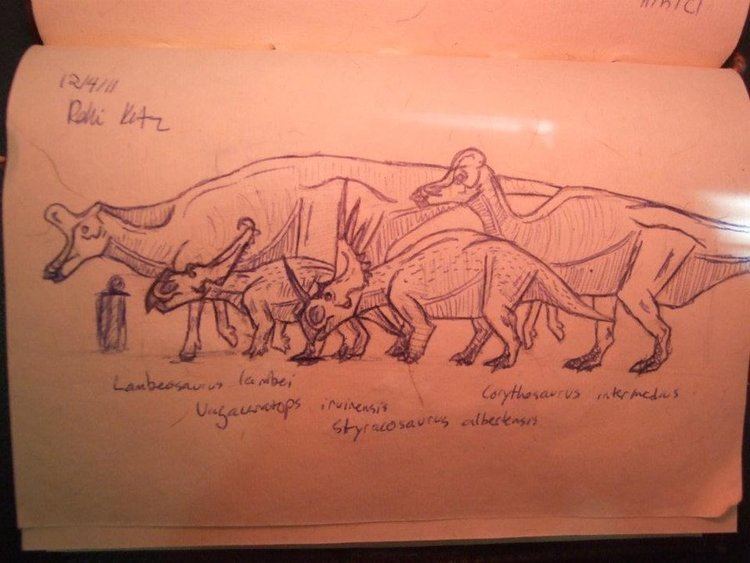
Geological setting

The Dinosaur Park Formation is composed of sediments that were derived from the erosion of the mountains to the west. It was deposited on an alluvial to coastal plain by river systems that flowed eastward and southeastward to the Bearpaw Sea, a large inland sea that was part of the Western Interior Seaway. That sea gradually inundated the adjacent coastal plain, depositing the marine shales of the Bearpaw Formation on top of the Dinosaur Park Formation.
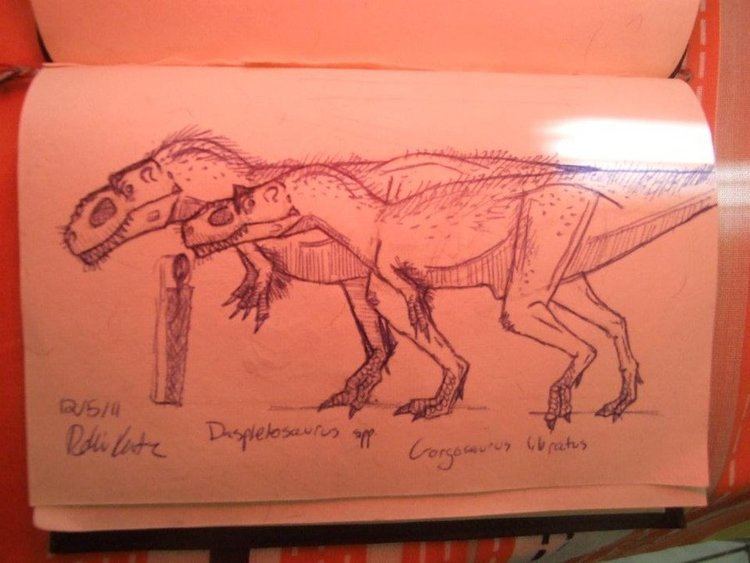
The Dinosaur Park Formation is about 70 metres (230 ft) thick at Dinosaur Park. The lower portion of the formation was laid down in fluvial channel environments and consists primarily of fine- to medium-grained, crossbedded sandstones. The upper portion, which was deposited in overbank and floodplain environments, consists primarily of massive to laminated, organic-rich mudstones with abundant root traces, and thin beds of bentonite. The Lethbridge Coal Zone, which consists of several seams of low-rank coal interbedded with mudstones and siltstones, marks the top of the formation.
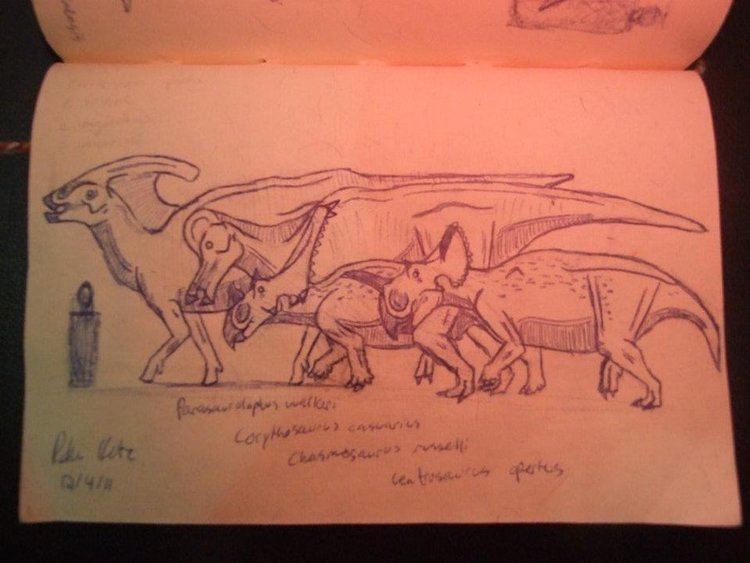
The sediments of the Dinosaur Park Formation are similar to those of the underlying Oldman Formation and they were originally included in that formation. The two formations are separated by a regional disconformity, however, and are distinguished by petrographic and sedimentologic differences. In addition, articulated skeletal remains and bonebeds are rare in the Oldman Formation but abundant in the Dinosaur Park Formation.
Biostratigraphy
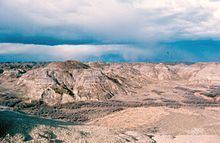
The Dinosaur Park Formation can be divided into at least two distinct faunas. The lower part of the formation is characterized by the abundance of Corythosaurus and Centrosaurus. This group of species is replaced higher in the formation by a different ornithischian fauna characterized by the presence of Lambeosaurus and Styracosaurus. The appearance of several new, rare species of ornithischian at the very top of the formation may indicate that a third distinct fauna had replaced the second during the transition into younger, non-Dinosaur Park sediments, at the same time an inland sea transgresses onto land, but there are fewer remains here. An unnamed pachyrhinosaur, Vagaceratops irvinensis, and Lambeosaurus magnicristatus may be more common in this third fauna.
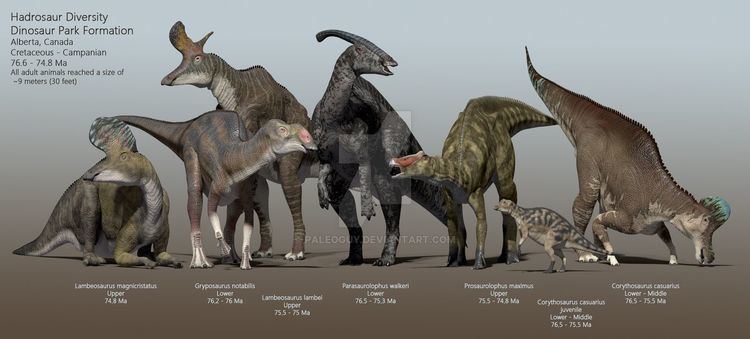
The timeline below follows a synthesis presented by Arbour et al. 2009 with additional information from Evans et al. 2009 and Penkalski, 2013. Megaherbivore Assemblage Zones (MAZ) follow data presented by Mallon et al., 2012.
Amphibians
Remains of the following amphibians have been found in the formation:
Albanerpetontidae (extinct, salamander-like amphibians)
Salienta (frogs)
Dinosaurs
Remains of the following dinosaurs have been found in the formation:
Ornithischians
Remains of the following Onrithischians have been found in the formation:
Ceratopsians
An unnamed Pachyrhinosaurus-like taxon has been recovered from the formation.
Ornithopods
At least one indeterminate hypsilophodont specimen has been recovered from the formation.
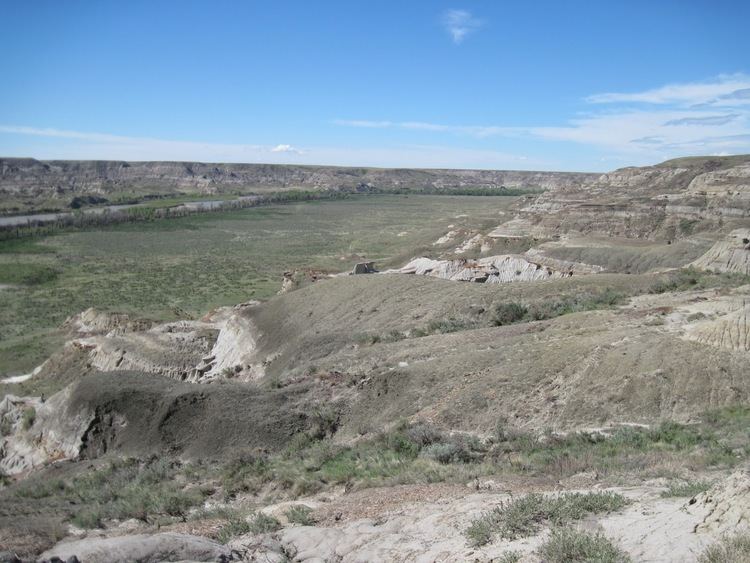
In a 2001 review of hadrosaur eggshell and hatchling material from the Dinosaur Park Formation, Darren H. Tanke and M. K. Brett-Surman concluded that hadrosaurs nested in both the ancient upland and lowlands of the formation's depositional environment. The upland nesting grounds may have been preferred by the less common hadrosaurs, like Brachylophosaurus or Parasaurolophus. However, the authors were unable to determine what specific factors shaped nesting ground choice in the formation's hadrosaurs. They suggested that behavior, diet, soil condition, and competition between dinosaur species all potentially influenced where hadrosaurs nested.
Sub-centimeter fragments of pebbly-textured hadrosaur eggshell have been reported from the Dinosaur Park Formation. This eggshell is similar to the hadrosaur eggshell of Devil's Coulee in southern Alberta as well as that of the Two Medicine and Judith River Formations in Montana, United States. While present, dinosaur eggshell is very rare in the Dinosaur Park Formation and is only found in two different microfossil sites. These sites are distinguished by large numbers of pisidiid clams and other less common shelled invertebrates like unionid clams and snails. This association is not a coincidence as the invertebrate shells would have slowly dissolved and released enough basic calcium carbonate to protect the eggshells from naturally occurring acids that otherwise would have dissolved them and prevented fossilization.
In contrast with eggshell fossils, the remains of very young hadrosaurs are actually somewhat common. Darren Tanke has observed that an experienced collector could actually discover multiple juvenile hadrosaur specimens in a single day. The most common remains of young hadrosaurs in the Dinosaur Park Formation are dentaries, bones from limbs and feet, as well as vertebral centra. The material showed little or none of the abrasion that would have resulted from transport, meaning the fossils were buried near their point of origin. Bonebeds 23, 28, 47, and 50 are productive sources of young hadrosaur remains in the formation, especially bonebed 50. The bones of juvenile hadrosaurs and fossil eggshell fragments are not known to have preserved in association with each other, despite both being present in the formation.
Theropods
In the Dinosaur Park Formation, small theropods are rare due to the tendency of their thin-walled bones to be broken or poorly preserved. Small bones of small theropods that were preyed upon by larger ones may have been swallowed whole and digested. In this context, the discovery of a small theropod dinosaur with preserved tooth marks was especially valuable. Possible indeterminate avimimid and therizinosaurid remains are known from the formation.
Fish
Remains of the following fish have been found in the formation:
Chondrichthyans
Acipenseriformes (sturgeons)
Holostean fish
Teleost fish
Invertebrates
Remains of the following invertebrates have been cound in the formation:
Freshwater bivalves
Freshwater gastropods
Mammals
Remains of the following mammals have been found in the formation:
Unknown therians: at least 1 species
Plant body fossils
The following plant body fossils have been found in the formation:
Angiosperms
Palynomorphs
Palynomorphs are organic-walled microfossils, like spores, pollen, and algae. The following palynomorphs have been found in the formation:
Unknown producers
Fungi
Chlorophyta (green algae and blue-green algae)
Pyrrhophyta (dinoflagellates, a type of marine algae)
Bryophytes (mosses, liverworts, and hornworts)
Anthocerotophyta (hornworts)Lycopodiophyta
Lycopodiaceae (club mosses)Polypodiophyta
Osmundaceae (cinnamon ferns)Pinophyta (gymnosperms)
Cycadaceae (cycads)Unknown gymnosperms: at least 3 species
Magnoliophyta (angiosperms)
Magnoliopsida (dicots)Liliopsida (monocots)Unknown angiosperms: at least 88 speciesChoristoderes
Choristoderes, or champsosaurs, were aquatic reptiles. Small examples looked like lizards, while larger types were superficially similar to crocodilians. Remains of the following Choristoderes have been found in the formation:
Crocodylians
Remains of the following Crocodylians have been found in the formation:
Lizards
Remains of the following lizards have been found in the formation:
Helodermatids
Necrosaurids
Teiids
Varanids
Xenosaurids
Plesiosaurs
Remains of the following Plesiosaurs have been found in the formation:
Pterosaurs
Remains of the following Pterosaurs have been found in the formation:
Turtles
Remains of the following turtles have been found in the formation:
Timeline of new taxa
The following timeline displays valid taxa first discovered in the dinosaur. Some species may have been referred to other genera subsequent to their initial description.
